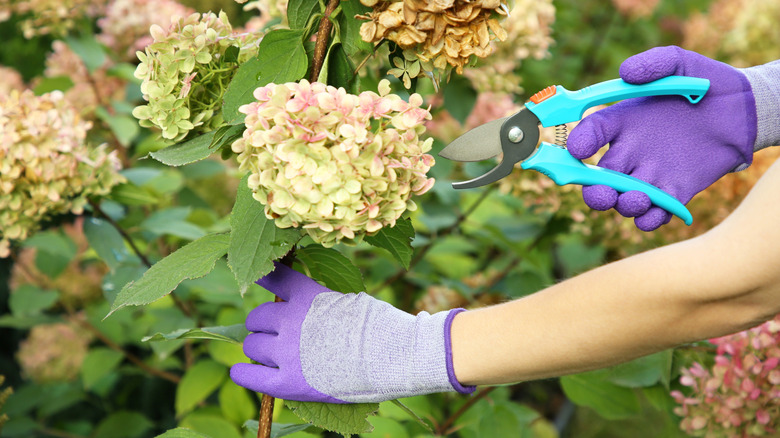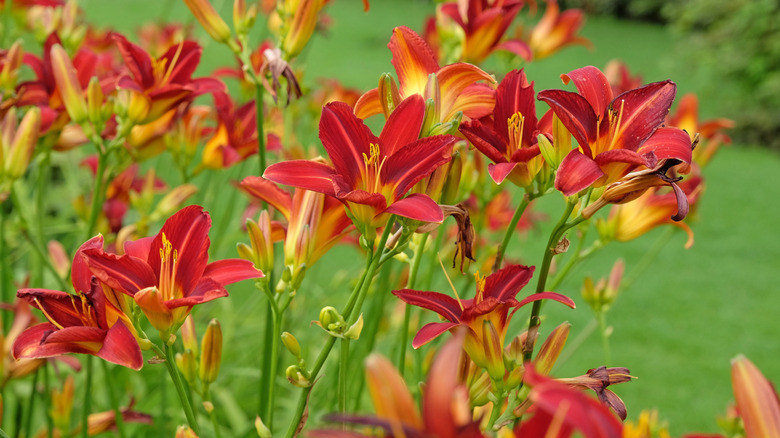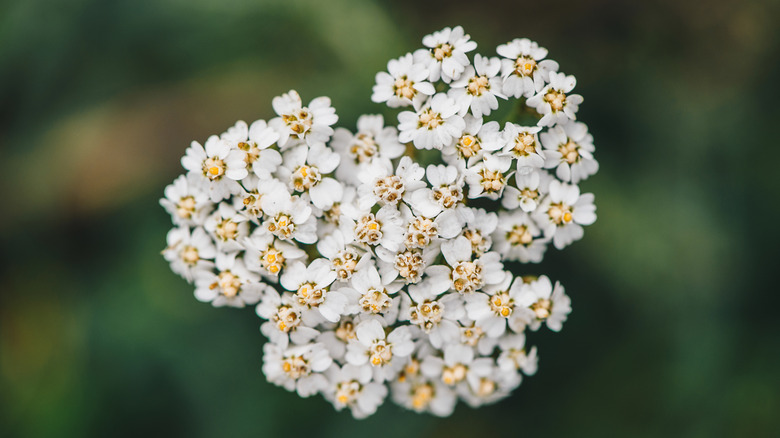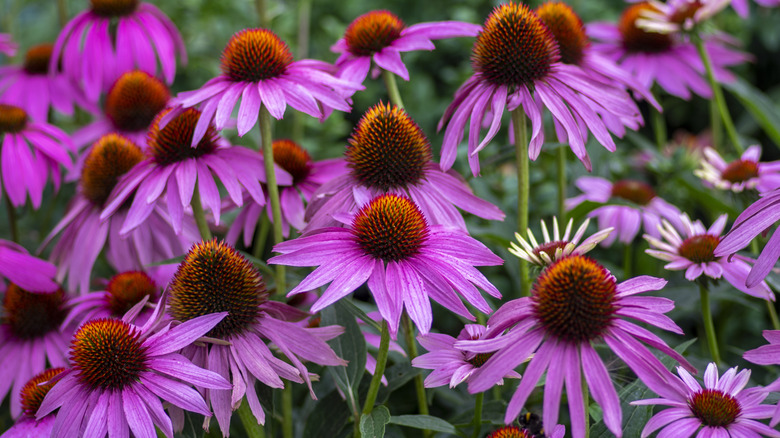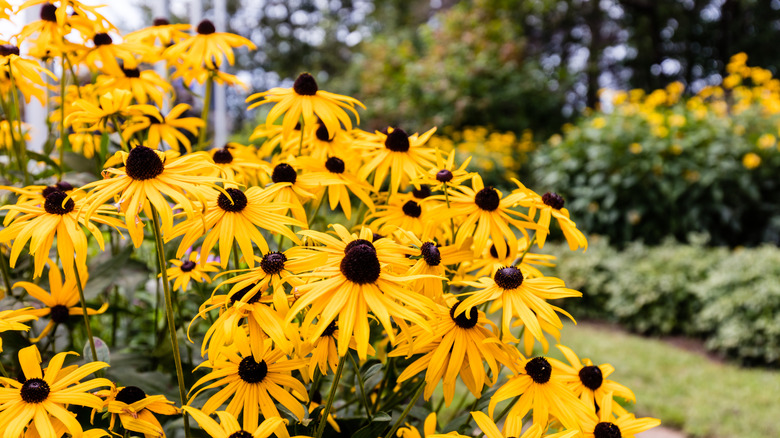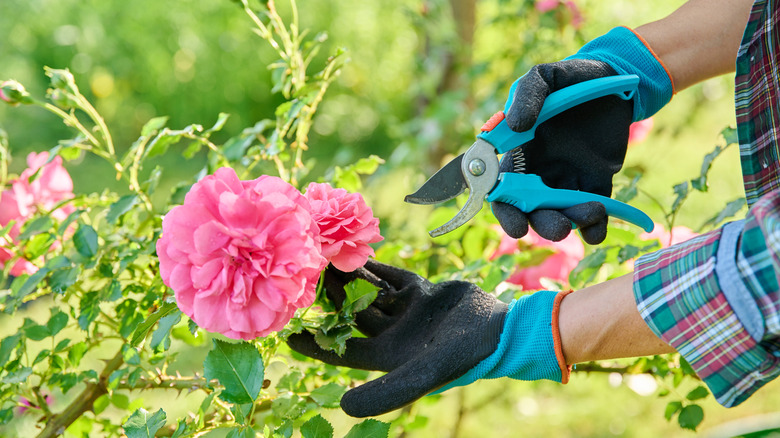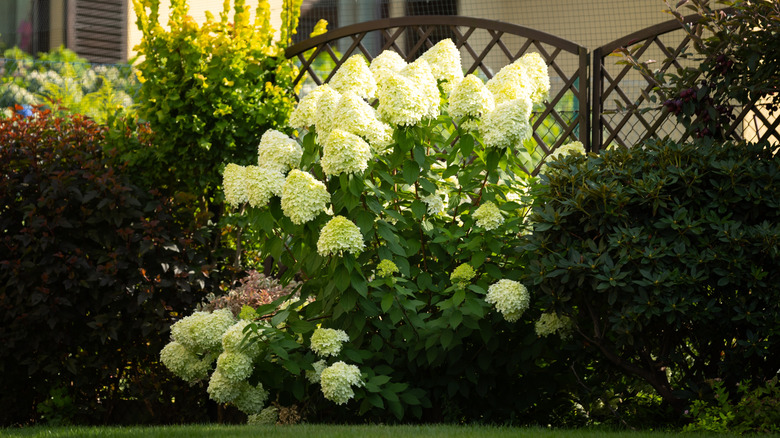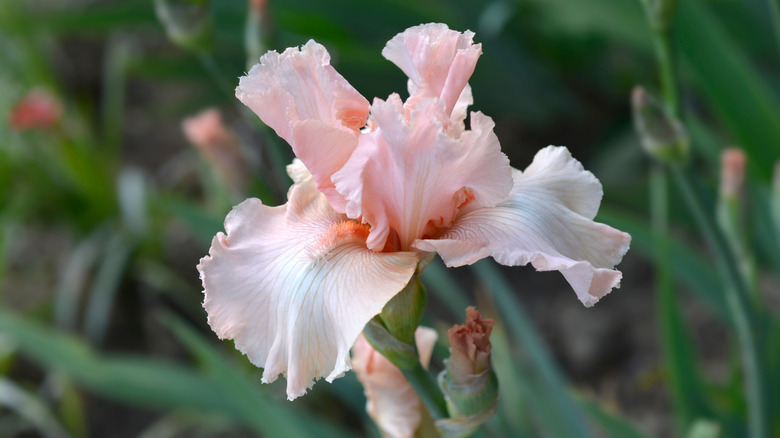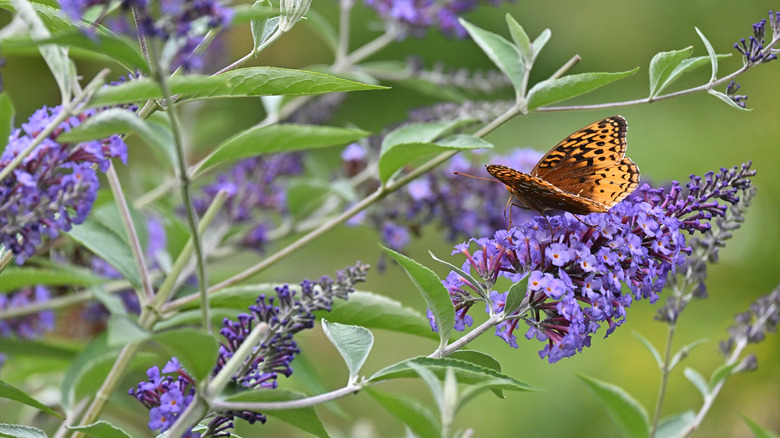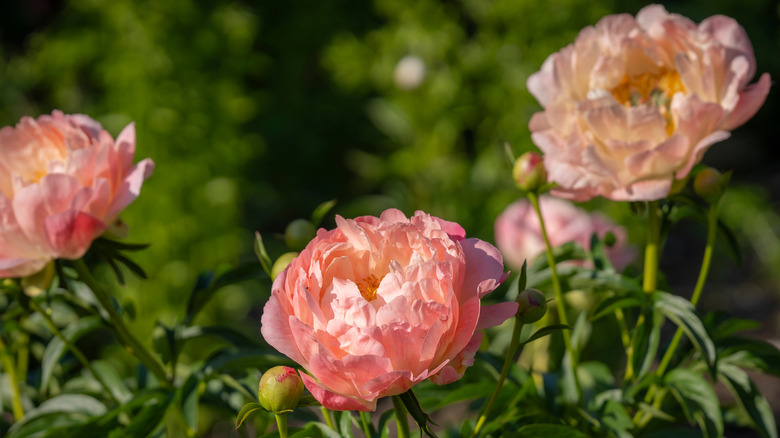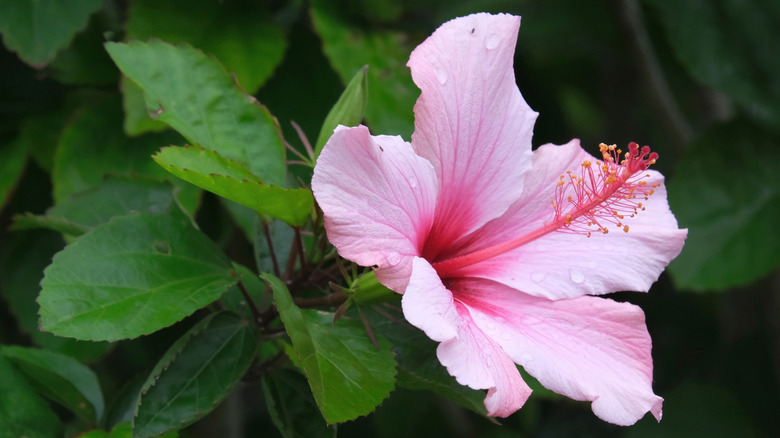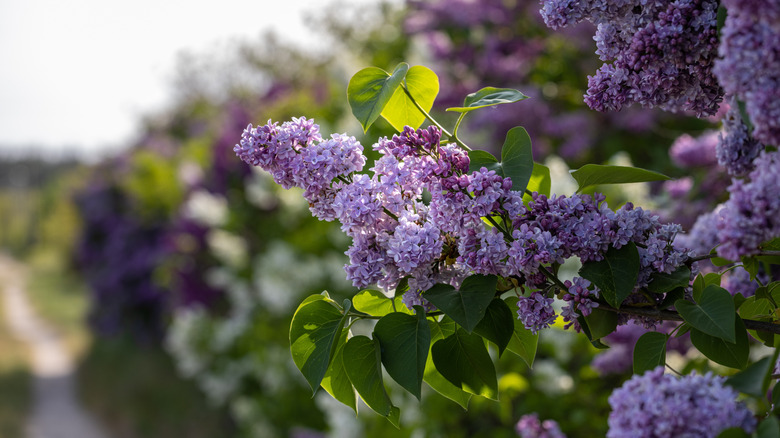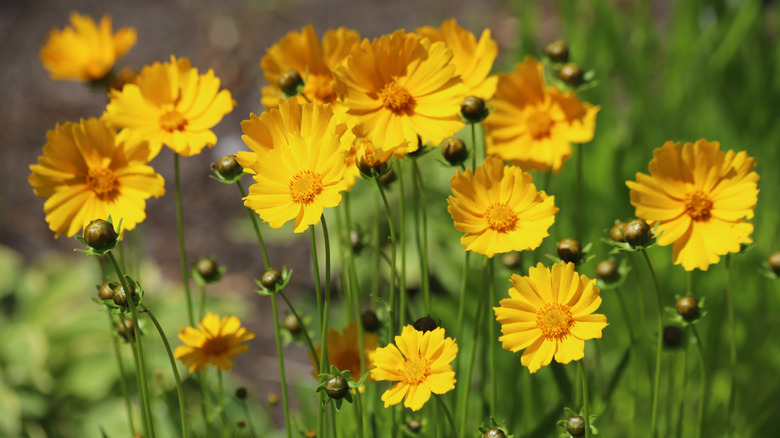When To Prune These 12 Perennials For Vibrant Summer Blooms
Perennials can be a gardener's dream since they come back every year to produce more beautiful blooms. But did you know that the right kind of pruning at the right time can ensure that your perennials will grow even more summer flowers? Sounds great, but many perennials follow their own rules.
There are three kinds of pruning strategies when it comes to trimming perennials for reblooming. First is deadheading, which involves cutting off dead or dying flowers. This helps the plant divert energy it was using to feed dying flowers into growing new ones. Then, there's cutting back wayward branches or lopping off the withered parts of the plant. This can help flowers and shrubs look less overgrown, but it can also help improve the health of the plant. Pinching is the third pruning technique. It involves trying to determine where flowers grow. If you pinch a center bud, then the plant might split the stalk and grow double blooms to either side. Or, conversely, if you pinch smaller buds on each side, you might encourage a larger flower to grow from the middle stalk.
Whatever pruning technique you employ, it's important to note that you always should use clean shears when cutting plants. Bacteria or fungus can live in the soil or sap of other plants, and if you don't clean clippers, you can wind up spreading it around your garden. You can learn how to sterilize pruning shears in a few easy steps. Read on for tips to prune 15 perennials for more summer flowers.
Trim day lilies when you see browning leaves
Daylilies (Hemerocallis) grow easily in sun or partial shade. These clumping perennials, hardy in zones 3 to 9, are avid producers — once established, a group can produce 200 to 400 flowers in a single season. If you want even more blooms next year, make sure to cut back any brown or withered leaves when you see them throughout spring or summer. Trim off dead flowers, as well as any yellow or spotted leaves to keep daylilies healthy and blooming. Finally, cut them back to the ground mid-season and end of season.
Prune yarrow in the fall for more blooms
If you're hoping for more pretty white yarrow flowers, then look to trim yarrow (Achillea) in the fall. After flowers die off, trim back browned or dead stalks. Trimming yarrow in the fall can help prevent disease or mold and avoid helping insects survive over the winter. Hardy in zones 3 through 9, yarrow can be a dependable perennial, commonly used as a ground cover. Leave about six inches of stalk or so, and it can be one of the last things you do in the garden before the first frost.
Trim cone flowers in the spring
While yarrow loves a trim in the fall, it's best to prune coneflowers (Echinacea laevigata) in the spring. If you leave coneflowers alone at the end of the season, they'll provide an important food source for birds in the winter when blooms are scarce. Coneflowers thrive in zones 3 to 8 and love neutral to slightly alkaline soil. You can also to prune coneflowers for continuous blooms, just pinch off any dead or dying flowers and you'll encourage the plant to grow more to replace them.
Cut black-eyed Susan flowers for bouquets
Cut black-eyed Susan (Rudbeckia) anytime for beautiful, freshly cut flowers for a beautiful bouquet in a vase on your tabletop. You'll encourage more flowers to grow during the growing season, which is usually mid-to-late summer. Deadheading black-eyed Susans regularly will also help grow more flowers. Native to North America, black-eyed Susans are hardy in zones 4 through 10. They like neutral to slightly acidic soil. These self-seeding perennials prefer full sunlight, but will make do with partial shade. The birds will enjoy their seeds over winter, so cut back in spring.
Don't deadhead old garden roses
If you have a variety of what is known as an old European garden rose, then always prune after the end of the flowering season. An early-summer bloomer, old garden roses tend to not respond well to deadheading — they are often called "once blooming."So the idea is to focus pruning efforts just on cutting off rotting or damaged wood stems. Old garden roses are known for their deep scents and their resistance to cold, since they thrive in zones 3 to 5 with some even hardy to zone 2.
How you cut a hydrangea is almost as important as when
When it comes to trimming Hydrangea paniculata, always cut just above a bud but not too close and not too far. Aim your shears at an angle about a quarter of an inch above a nub on the stem. You can prune them in the fall, late winter, or spring. However, beware that different species have different pruning needs. Panicle hydrangeas are versatile blooming perennials that will thrive in clay, silt or sand soils in zones 3 to 8. They'll bloom from summer to fall with the right care.
Deadhead bearded irises daily
Bearded irises (Iris x germanica) can benefit from deadheading regularly. This could mean trimming back dead or dying flowers almost daily since some of their blooms might only last 24 hours. After flowers finish blooming, cut back stalks to the foliage to help bearded irises avoid disease and bloom better next season. The bearded iris prefers well-draining soil, though it can also tolerate some periods of drought. Bearded irises do well in winters, even down to zones 3.
Leave the butterfly bush alone in the winter
It's best to prune your butterfly bush (Buddleja) in early spring before new growth appears and then leave it alone in the winter. That way, you can shape the shrub and not cut off new blooms that will attract butterflies, bees, and hummingbirds to your garden. Butterfly bush is a hardy perennial that will tolerate both poor soil and drought. In milder climates like zones 7 through 9, it'll act as an evergreen. Butterfly bush needs a lot of sunlight and neutral soil to thrive.
Don't cut back peonies right after they bloom
Peonies (Paeonia hybrids) can be wonderfully fragrant perennials, but don't succumb to the temptation to trim them back too early. While you can cut back dead flowers and leaves, don't trim a peony too much in the summer because it needs time in the sun to absorb energy for the next blooming season (late spring through early summer). Peonies grow well in zones 3 to 8 with fertile, acidic soil. They need a lot of air circulation to thrive, so don't crowd them or plant them in corners or near walls.
Trim hibiscus in late winter for more flowers
If you want a bushier and fuller hibiscus plant, trim it in late winter. If you feel the hibiscus is taking over the yard, don't be afraid to use those shears generously since the plant can withstand a substantial cut without any ill effects. With over 300 species of hibiscus flowers, you can find a wide array of colors including pink, red, white, and purple. The hardy hibiscus hybrid is a no fuss herbaceous perennial that loves zones 4 through 9 and prefers alkaline soil.
Prune lilacs regularly for the most blooms
If you want more amazingly fragrant flowers for common lilac (Syringa vulgaris) bushes, then regular pruning is essential. Older branches will slowly start producing fewer blooms, so it's a good idea to trim back old or damaged canes at the end of blooming season. A good rule of thumb is to maintain about 12 healthy branches per plant. While you can cut the plant to the ground, avoid doing so as it can stress lilacs. Deadheading is only really useful for younger lilac plants. Common lilacs thrive in zones 3 to 7 and love sun or partial shade.
Deadhead tickseed flowers regularly
Tickseed (Coreopsis grandiflora) flowers can be pretty perennials that also happen to be pest-resistant. But they need regular deadheading if you want new flowers to continue to bloom all season. Fair warning: failing to do this might result in bare flower stalks. Tickseed grows well in zones 4 through 9 and will tolerate soil on the drier side. Tickseed prefers sandy or rocky soils, and it'll grow about a foot tall when mature.
